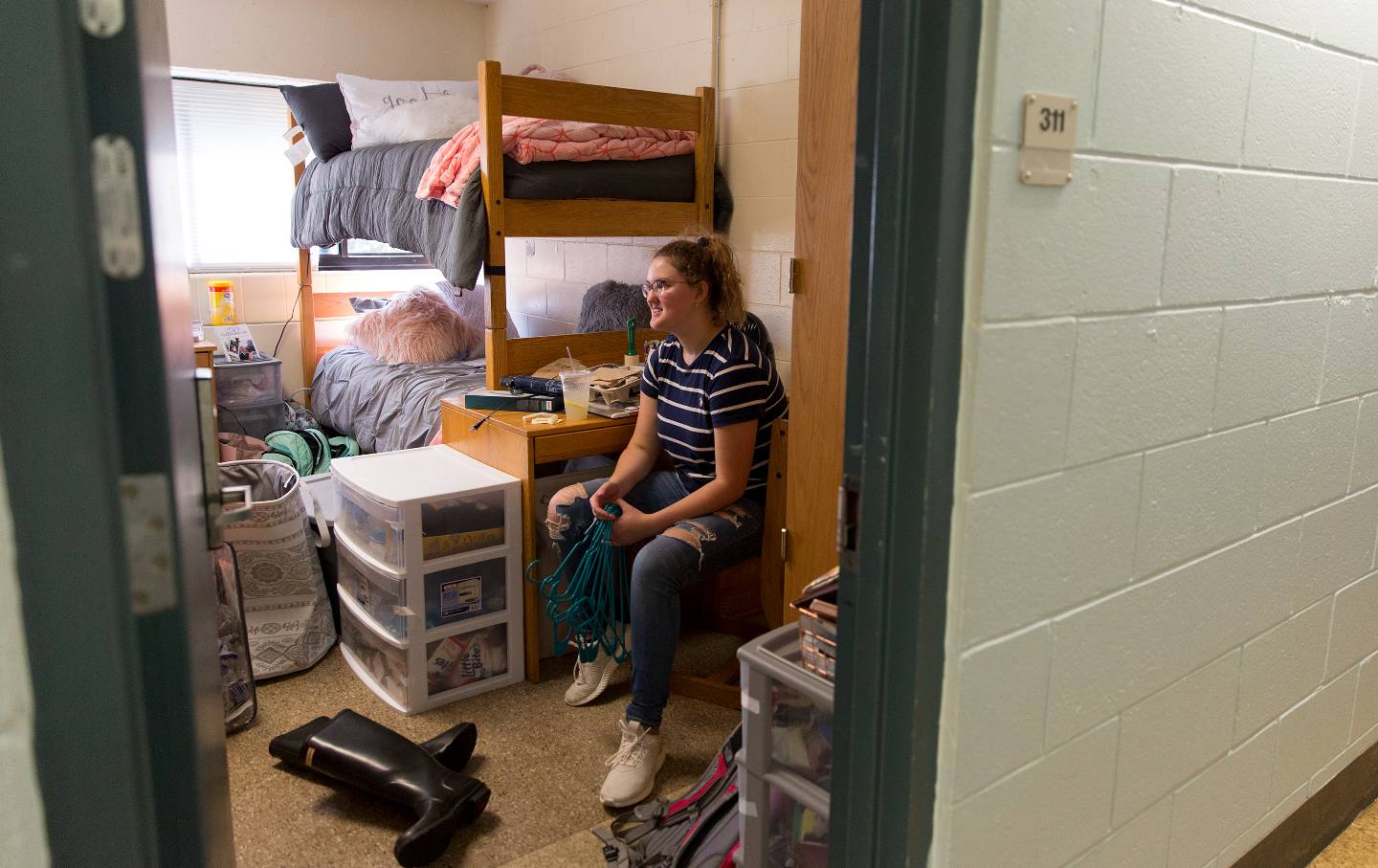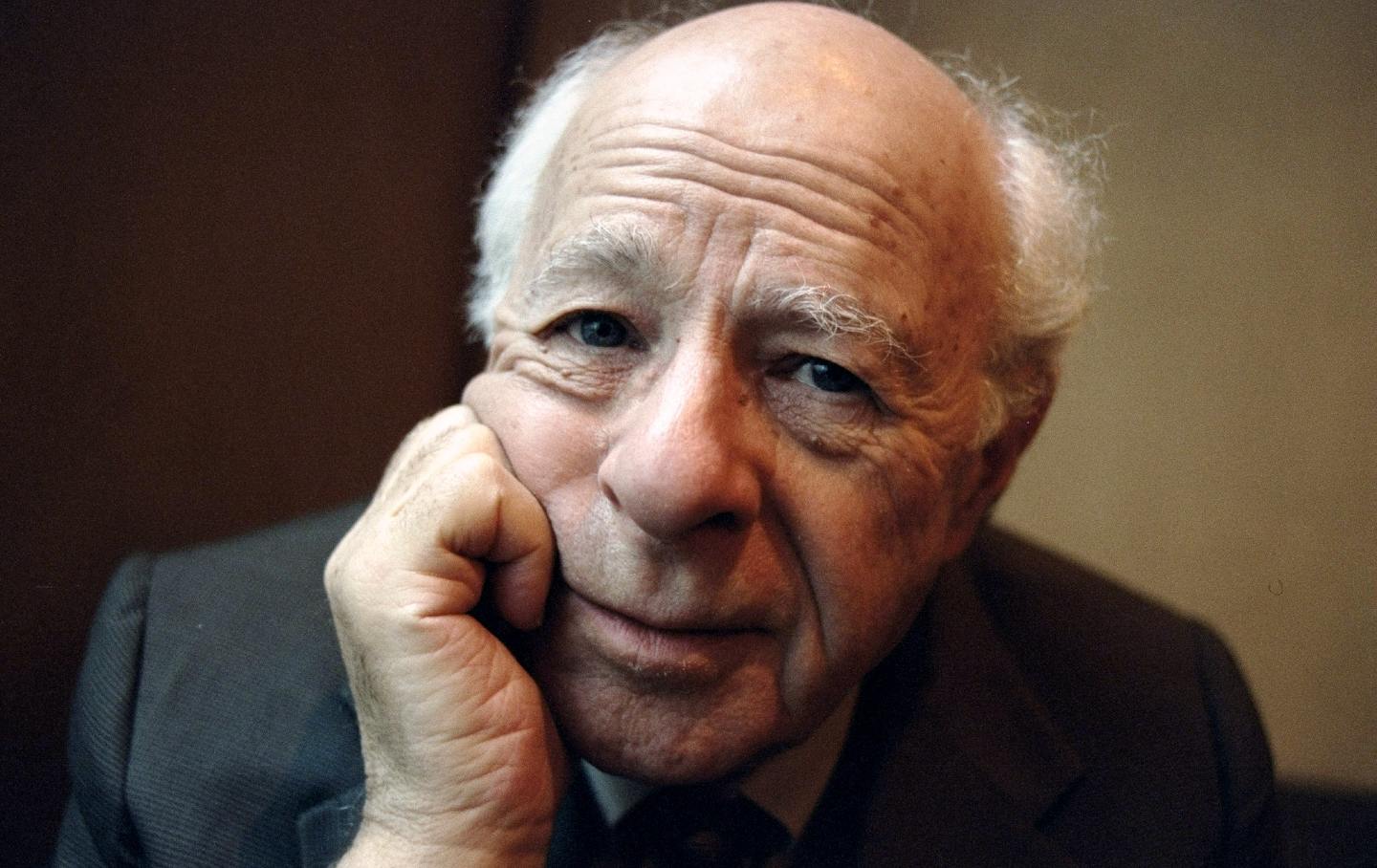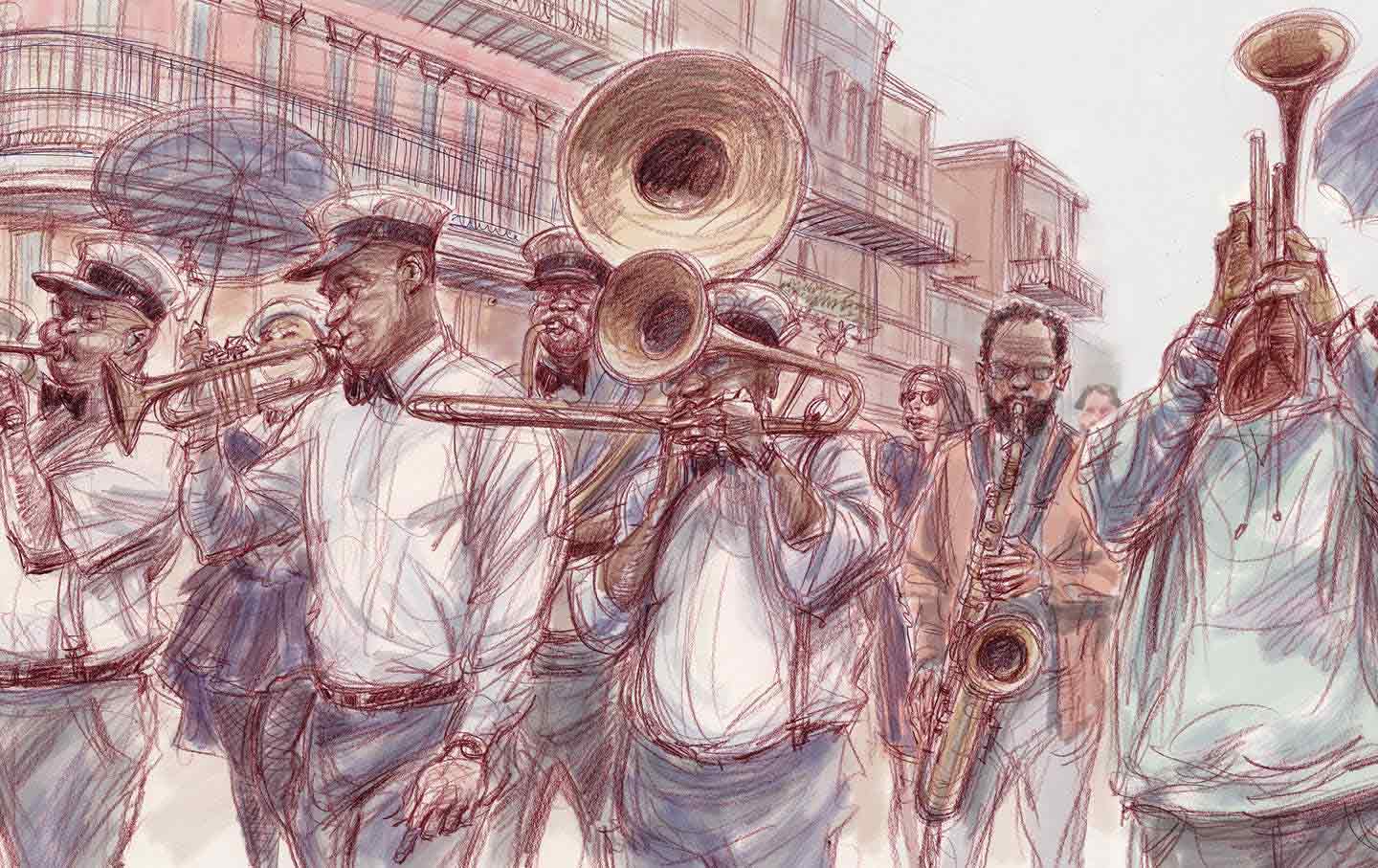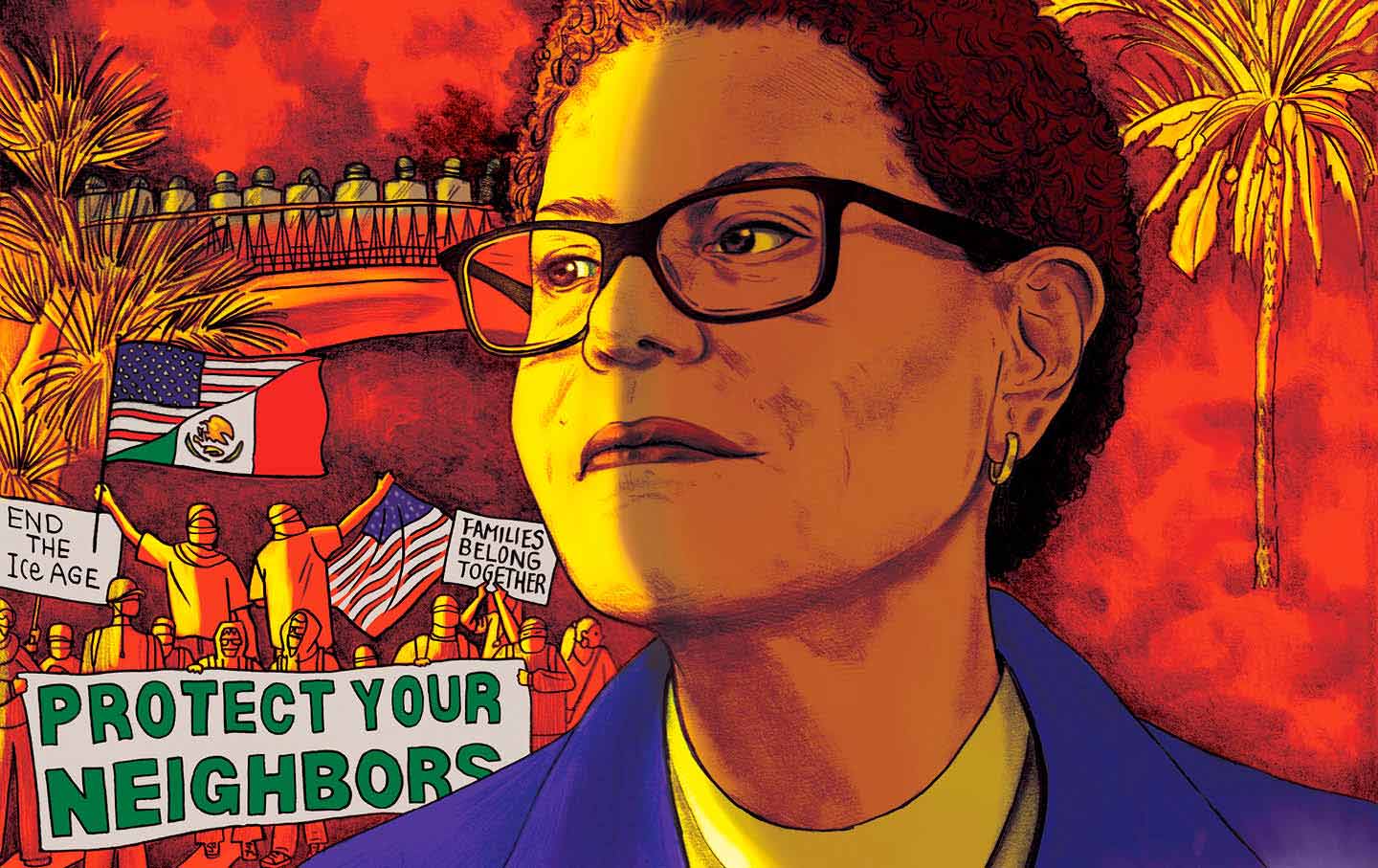College Dorms Are Terrible—and More Expensive Than Ever
In the past 30 years, university housing costs have risen substantially. But in the housing world, higher prices don’t always guarantee higher standards.

A student at Southern Maine Community College in her temporary housing at Surfsite Hall after black mold was discovered in her dorm.
(Brianna Soukup / Getty)During her summer internship as an undergraduate neuroscience researcher, Jane Doe was required to live on Columbia University’s campus. But upon moving into their apartment, Jane and her five roommates found mold throughout the bedrooms, bathrooms, and common spaces. The students quickly brought the issue up to Columbia’s housing staff, and maintenance workers were dispatched to paint over the moldy areas. Each time, however, the mold would simply spread through the fresh layer of paint and return a few days later.
Jane, who is asthmatic, started to experience dizziness, nausea, and trouble breathing. Following a sudden hospitalization, she was finally relocated to another apartment on campus, only to find even more mold on the floors.
Her medical issues took valuable time away from the program—which was designed for students from disadvantaged backgrounds—and Jane now faces potential long-term health consequences. “I’ve had to tell everyone in my life that I spent most of those nine weeks at hospitals and doctors appointments, instead of working on an actual project,” she said. “I had great program coordinators, amazing graduate students working with me, but the institution itself was an absolute let down.”
Since 2017, there have been at least 140 notable cases of mold exposure in college dorms across the country. The Center for Disease Control and Prevention reports that mold exposure, especially for those with asthma, can lead to the development of severe health effects such as fungal infections and difficulty breathing, the latter of which Jane says has still worsened after this incident.
“Many dorm rooms have air quality issues because of aging buildings with small, underlit rooms and limited airflow,” writes the Urban Institute’s Housing Matters. “Because interior living spaces harbor moisture, these features create the perfect breeding ground for mold.”
Colleges in the United States often require on-campus residency for freshman students, but if these dorms do not adhere to basic health code standards—like Jane’s—these mandates can be harmful.
In the past 30 years, dorm costs have risen substantially, increasing over 100 percent at public four-year institutions. “Most are old and require a great deal of maintenance. New ones must be financed, adding to the already heavy debt load of colleges,” writes Bob Hildreth for CommonWealth Beacon.
Amid the ongoing housing crisis, there are few affordable alternatives. The University of Tennessee in Knoxville, “which charges state residents $11,332 in undergraduate tuition a year, met excess housing demand last year by renting out a nearby Holiday Inn,” according to Forbes.
In Manhattan, the average one-bedroom rental comes with a price tag of over $4,300 and may lack certain amenities that dorms usually provide, such as security or being close to campus. New York University, one of Manhattan’s largest real estate owners, charges students $12,900 per semester to have their own studio apartment, though that price can be reduced to as low as $4,950 by rooming with two other people and forgoing a kitchen.
For schools in New York’s CUNY system—where a majority of students commute—staying in a dormitory is not required. However, for out-of-state or long-distance students, who make up 38 percent of the student body, the options are bleak.
In 2022, Mayor Eric Adams announced that Hunter College’s Brookdale dorms—the school’s most affordable housing—would be demolished in place of a brand new science hub. But neither Adams nor Hunter have publicly discussed viable replacement housing, causing concern for the Hunter community, where students can struggle to afford dorm options outside of Brookdale, which can range from $12,000–16,000 per academic year on top of tuition.
Around Thanksgiving last year, water began pouring through the ceiling of Cecilia Brown’s apartment. The flooding destroyed many of her belongings, including her diary, her father’s vintage camera, and a piece of her baby blanket. The sprinkler system in Hunter’s 79th Street Apartments was set off by an oven fire in the apartment above her. Months before, Brown and her roommates submitted work orders to the building’s maintenance about the preexisting water damage in the room, such as bubbling in the walls and cracks in the ceilings.
Popular
“swipe left below to view more authors”Swipe →“They did not respond to any of our work order requests, and by the time that they did, we probably fixed it ourselves,” said Brown. She was eventually reassigned to a different room and reimbursed for the damage of her belongings several months later.
Brown believes all student housing should have a third-party representative conduct routine check-ins at dormitories to see if the students who live there are satisfied with their living conditions. She also thinks colleges and universities should be required to provide tours of their residences before students apply for housing, rather than having students sign sight unseen for what is often branded “luxury” housing.
In the housing world, these high prices do not always guarantee quality. At Pace University’s 33 Beekman Hall, the tallest residence hall in the world, many of its amenities were temporarily closed in April—including the laundry room—after the collapse of an adjacent parking garage due to faulty infrastructure. Students were not offered alternative resources, nor were they given access to other dorms to use their amenities unless they were signed in by another resident. In fall 2023, Maria’s Tower, another of Pace’s 11 residence halls, was closed for refurbishment after students reported mold contamination.
Kellie, a sophomore at Pace, where dormitory rooms can cost up to $10,000 per semester, said that the high prices for small, low-quality dorms is what led her to choose off-campus housing. Kellie was originally assigned to be in a triple room—which was actually a double with a bunk bed added—at a residence hall for the fall semester. “When I got my housing assignment, I cried.”
The struggles faced by college students are often normalized; the stereotypical freshman is crammed into a tiny dorm, slurping instant ramen. But research conducted by environmental psychologists and the Urban Institute’s Housing Matters Initiative states that a poor quality of housing, an instable situation, and exposure to hazardous conditions can be detrimental to a student’s mental health.
Along with widespread mold exposure, flame retardants that are commonly used on dorm room furniture can also pose serious risks. A 2017 study of dust samples at two New England college campuses found over 40 different chemical flame retardants that can be linked to cancer, neurological impairment, and endocrine disruption.
Dormitories are included in NYC’s Housing Maintenance Code, and if students contact 311 for issues related to their housing, the NYC Department of Buildings will open a case and personally examine their conditions, said Tanisha B., an official from HPD’s Office of Neighborhood Strategies.
But Laura Wolf-Powers, a professor of Urban Policy and Planning at Hunter College, suggests that in the same way the Department of Motor Vehicles can revoke or suspend a license, landlords should have similar consequences if they were not operating their buildings in accordance with state health codes and other standards.
“I have a friend, who is actually a professor at City College, who has this idea that in order to own and operate a building, you have to have a license, in the way somebody needs to have a license in order to drive a car, because the same kinds of health and safety issues are at stake,” said Wolf-Powers. “Drivers licenses are to make sure you’re fit to drive and know the rules. Why would someone owning and operating a building not need the same kind of certification? Then if you have that, then that could be revoked if you were not performing.”
While Elsia Vasquez, founder of tenant rights advocacy group People Against Landlord Abuse and Tenant Exploitation (PA’LANTE), says her organization has never worked with students, but she is up for the challenge.
Vasquez started PA’LANTE in 2006 to provide free legal services for (primarily) low-income tenants experiencing poor-quality and unsafe housing conditions in New York City. Some of the conditions tenants have battled their landlords in court over include collapsed ceilings, toxic mold, and other experiences similar to what students have reported facing. One of PA’LANTE’s building blocks as a powerful advocacy group, which has led to the repair of 1,532 rent-stabilized units, is the empowerment of tenants who have felt violated of their housing rights.
That organizing and accountability could be the key to a cleaner, safer life for students. American colleges and universities face a facilities backlog of over $112 billion, according to a 2021 report from APPA, leading to the deferral of much-needed maintenance and repairs across the country. “The University knew about the mold conditions in the dormitories for many years but failed to address the problem or disclose it to incoming students,” reads a lawsuit filed by Indiana University students after a mold outbreak in 2019.
“We’re money to them,” said Brown. “Our humanity gets completely lost in the wheels of bureaucracy. That’s just how it is.”
Disobey authoritarians, support The Nation
Over the past year you’ve read Nation writers like Elie Mystal, Kaveh Akbar, John Nichols, Joan Walsh, Bryce Covert, Dave Zirin, Jeet Heer, Michael T. Klare, Katha Pollitt, Amy Littlefield, Gregg Gonsalves, and Sasha Abramsky take on the Trump family’s corruption, set the record straight about Robert F. Kennedy Jr.’s catastrophic Make America Healthy Again movement, survey the fallout and human cost of the DOGE wrecking ball, anticipate the Supreme Court’s dangerous antidemocratic rulings, and amplify successful tactics of resistance on the streets and in Congress.
We publish these stories because when members of our communities are being abducted, household debt is climbing, and AI data centers are causing water and electricity shortages, we have a duty as journalists to do all we can to inform the public.
In 2026, our aim is to do more than ever before—but we need your support to make that happen.
Through December 31, a generous donor will match all donations up to $75,000. That means that your contribution will be doubled, dollar for dollar. If we hit the full match, we’ll be starting 2026 with $150,000 to invest in the stories that impact real people’s lives—the kinds of stories that billionaire-owned, corporate-backed outlets aren’t covering.
With your support, our team will publish major stories that the president and his allies won’t want you to read. We’ll cover the emerging military-tech industrial complex and matters of war, peace, and surveillance, as well as the affordability crisis, hunger, housing, healthcare, the environment, attacks on reproductive rights, and much more. At the same time, we’ll imagine alternatives to Trumpian rule and uplift efforts to create a better world, here and now.
While your gift has twice the impact, I’m asking you to support The Nation with a donation today. You’ll empower the journalists, editors, and fact-checkers best equipped to hold this authoritarian administration to account.
I hope you won’t miss this moment—donate to The Nation today.
Onward,
Katrina vanden Heuvel
Editor and publisher, The Nation
More from The Nation

The Longest Journey Is Over The Longest Journey Is Over
With the death of Norman Podhoretz at 95, the transition from New York’s intellectual golden age to the age of grievance and provocation is complete.

Organized Labor at a Crossroads Organized Labor at a Crossroads
How can unions adapt to a new landscape of work?

The Epstein Survivors Are Demanding Accountability Now The Epstein Survivors Are Demanding Accountability Now
The passage of the Epstein Files Transparency Act is a big step—but its champions are keeping the pressure on.

The Fight to Keep New Orleans From Becoming “Everywhere Else” The Fight to Keep New Orleans From Becoming “Everywhere Else”
Twenty years after Katrina, the cultural workers who kept New Orleans alive are demanding not to be pushed aside.

Breaking the LAPD’s Choke Hold Breaking the LAPD’s Choke Hold
How the late-20th-century battles over race and policing in Los Angeles foreshadowed the Trump era.

Mayor of LA to America: “Beware!” Mayor of LA to America: “Beware!”
Trump has made Los Angeles a testing ground for military intervention on our streets. Mayor Karen Bass says her city has become an example for how to fight back.


